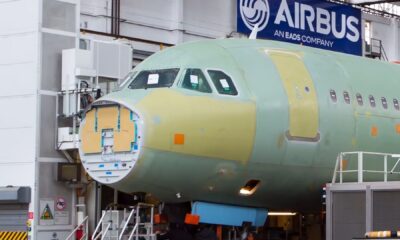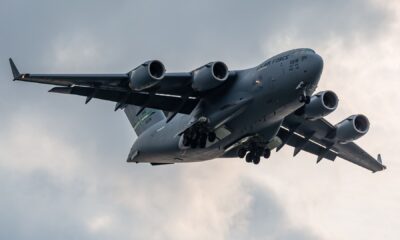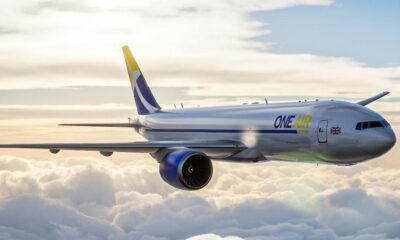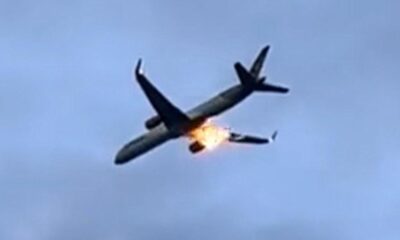World
Examining the Distinctive Nose Designs of Boeing and Airbus Aircraft

The design differences between Boeing and Airbus aircraft noses have intrigued aviation enthusiasts and industry experts alike. While both manufacturers produce a variety of commercial jets, Boeing aircraft typically feature more pointed noses compared to the rounder designs of Airbus models. This distinction arises from a combination of historical design choices, aerodynamic considerations, and brand identity.
Understanding Nose Shapes in Aviation
At transonic speeds, which most commercial jets operate within, a rounded nose is generally more aerodynamically efficient. Nevertheless, Boeing’s designs, particularly in models like the 737 and 777, maintain a sharper profile, resembling a bird’s beak. In contrast, Airbus aircraft, such as the A320 and A350, exhibit a bulbous, dolphin-like nose shape. This disparity becomes particularly evident when comparing aircraft that serve similar purposes, as most narrowbody and widebody jet designs share similar nose characteristics except for notable models like the A380 and Boeing 747.
Despite the apparent differences, the impact of nose design on overall aerodynamic performance is relatively minor when compared to factors such as wing design. Consequently, updates to newer aircraft models—such as the A330neo and Boeing 777X—have primarily focused on wing enhancements rather than nose modifications.
Historical Context and Design Philosophy
The evolution of Boeing’s nose designs can be traced back to its long-standing presence in the aviation industry. Founded in the early 20th century, the company pioneered many elements of commercial air travel. Early models like the 707, 727, and 737 featured similar nose shapes, which became a hallmark of the brand. As Boeing engineers developed these designs through wind tunnel testing before the advent of computer modeling, familiarity with these shapes influenced subsequent models.
Airbus, on the other hand, emerged in the 1970s and adopted a different design philosophy. The A320, introduced in the 1980s, benefited from advanced computer modeling, allowing for a more aerodynamic nose shape. According to aviation expert Mentour Pilot, this design leads to slightly enhanced efficiency, although the difference is not substantial enough to warrant a redesign of Boeing’s established nose shapes.
Boeing’s emphasis on higher cruise Mach numbers in the 1950s also played a role in shaping its aircraft designs. The pointed nose reduces wave drag as planes approach transonic speeds, a feature that has been retained in models like the 737 and 757.
In contrast, Airbus prioritizes cockpit space and pilot visibility. The rounded nose of Airbus models allows for a more spacious cockpit, facilitating better ergonomics and easier access to avionic systems. With a maximum internal cabin width of 12 feet and one inch for the A320, compared to 11 feet and seven inches for the 737, Airbus has created a design that enhances both pilot and passenger experience.
While the 787 Dreamliner features a more blended, organic nose design, it straddles the line between Boeing and Airbus aesthetics. This shift indicates a possible evolution in future aircraft designs, as technology advances and aerodynamic efficiency becomes increasingly prioritized.
The debate surrounding the efficiency of nose shapes continues, with some experts arguing that Airbus’s design may be slightly more suited for its intended operating speeds. Nevertheless, the differences in performance are minimal when compared to the substantial impact of wing design, materials, and overall aircraft structure.
Ultimately, while the distinct nose shapes of Boeing and Airbus aircraft provide a visual cue for passengers and enthusiasts, they represent more than just aesthetic choices. These designs reflect the companies’ respective histories, engineering philosophies, and priorities in the competitive aviation market. The ongoing evolution of aerospace technology may lead to further innovations in aircraft design, potentially blurring the lines that currently separate Boeing’s pointed noses from Airbus’s rounded ones.
-

 World5 days ago
World5 days agoCoronation Street’s Shocking Murder Twist Reveals Family Secrets
-

 Entertainment4 months ago
Entertainment4 months agoKate Garraway Sells £2 Million Home Amid Financial Struggles
-

 Entertainment3 months ago
Entertainment3 months agoAnn Ming Reflects on ITV’s ‘I Fought the Law’ Drama
-

 Entertainment2 days ago
Entertainment2 days agoAndrew Pierce Confirms Departure from ITV’s Good Morning Britain
-

 Health3 months ago
Health3 months agoKatie Price Faces New Health Concerns After Cancer Symptoms Resurface
-

 Entertainment4 weeks ago
Entertainment4 weeks agoCoronation Street Fans React as Todd Faces Heartbreaking Choice
-

 World4 weeks ago
World4 weeks agoBailey Announces Heartbreaking Split from Rebecca After Reunion
-

 Entertainment1 week ago
Entertainment1 week agoTwo Stars Evicted from I’m A Celebrity Just Days Before Finale
-

 World1 week ago
World1 week agoKevin Sinfield Exceeds Fundraising Goal Ahead of Final Marathons
-

 Entertainment3 months ago
Entertainment3 months agoCoronation Street’s Carl Webster Faces Trouble with New Affairs
-

 Entertainment3 months ago
Entertainment3 months agoWhere is Tinder Swindler Simon Leviev? Latest Updates Revealed
-

 Entertainment4 months ago
Entertainment4 months agoMarkiplier Addresses AI Controversy During Livestream Response





















